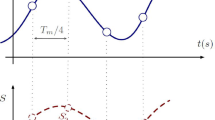Abstract
The goal of this work is to design thermal waves specifically for pulsed-phase infrared thermography (PPT) of bonded joints and to test their effectiveness on adhesive lap joints in carbon-fiber reinforced polymers structures. The method was applied to both single and double lap joint specimens to test different defect depths and multiple lap joint interfaces. An optimal thermal wave was designed for each specimen type based on the blind frequency information obtained from square pulse thermal wave excitation of the lap joint specimens. Modifications to the optimal thermal wave were then implemented based on the physical limitations of the lamp systems and different threshold settings for the blind frequency calculation. Thermal input waves based on the linear combination of discrete frequency waves were also implemented. The discrete frequency waves improved the defect image contrast in both the single and double lap joint specimens, while the optimal thermal input wave had the opposite effect and instead highlighted surface features. The difference in performance between the two thermal input waves is presumed to be due to the ability to separate frequency components in the transformation of data and not due to a critical thermal energy input threshold.
















Similar content being viewed by others
References
Baker A (1997) Joining and repair of aircraft composite structures. In: Mallick PK (ed) Composite engineering handbook (A 98–11526 01–24). Marcel Dekker, Inc., New York, pp 671–776
Baker A (1999) Bonded composite repair of fatigue-cracked primary aircraft structure. Compos Struct 47(1):431–443
Ashcroft IA, Hughes DJ, Shaw SJ (2000) Adhesive bonding of fibre reinforced polymer composite materials. Assem Autom 20(2):150–161
Da Silva LF, Adams RD, Gibbs M (2004) Manufacture of adhesive joints and bulk specimens with high-temperature adhesives. Int J Adhes Adhes 24(1):69–83
Roach D, Center FAA (2009) Methodology for assessing the reliability of nondestructive inspections on wind turbine blades. In: Wind Turbine Reliability Workshop
Maldague X, Marinetti S (1996) Pulse phase infrared thermography. J Appl Phys 79(5):2694–2698
Ibarra-Castanedo CI (2005) Quantitative subsurface defect evaluation by pulsed phase thermography: depth retrieval with the phase. Dissertation, Université Laval
Bai W, Wong BS (2001) Evaluation of defects in composite plates under convective environments using lock-in thermography. Meas Sci Technol 12(2):142
Mulaveesala R, Tuli S (2006) Theory of frequency modulated thermal wave imaging for nondestructive subsurface defect detection. Appl Phys Lett 89(19):191913
Mulaveesala R, Tuli S (2005) Implementation of frequency-modulated thermal wave imaging for non-destructive sub-surface defect detection. Insight-Non-Destr Test Cond Monit 47(4):206–208
Ghali VS, Mulaveesala R, Takei M (2011) Frequency-modulated thermal wave imaging for non-destructive testing of carbon fiber-reinforced plastic materials. Meas Sci Technol 22(10):104018
Brigham EO (1988) The fast fourier transform and its applications. Prentice Hall, Englewood Cliffs
Meola C, Carlomagno GM, Giorleo L (2003) Non-destructive evaluation of bonded structures with lock-in thermography. J Adhes Sci Technol 17(9):1207–1222
Waugh RC, Dulieu-Barton JM, Quinn S (2011) Pulse phase thermography and its application to kissing defects in adhesively bonded joints. Appl Mech Mater 70:369–374
Schroeder JA, Ahmed T, Chaudhry B, Shepard S (2002) Non-destructive testing of structural composites and adhesively bonded composite joints: pulsed thermography. Compos A: Appl Sci Manuf 33(11):1511–1517
Genest M, Martinez M, Mrad N, Renaud G, Fahr A (2009) Pulsed thermography for non-destructive evaluation and damage growth monitoring of bonded repairs. Compos Struct 88(1):112–120
Klein MT, Ibarra-Castanedo C, Maldague XP, Bendada A (2008) A straightforward graphical user interface for basic and advanced signal processing of thermographic infrared sequences. In: SPIE Defense and Security Symposium. International Society for Optics and Photonics pp 693914–693914
Shin P (2013) Non-destructive Inspection in Adhesively-Bonded Joints using Pulsed Phase Thermography. MS Thesis, North Carolina State University
Author information
Authors and Affiliations
Corresponding author
Rights and permissions
About this article
Cite this article
Wu, X., Peters, K. Non-Destructive Inspection of Adhesively Bonded Joints using Amplitude Modulated Thermography. Exp Mech 55, 1485–1501 (2015). https://doi.org/10.1007/s11340-015-9997-0
Received:
Accepted:
Published:
Issue Date:
DOI: https://doi.org/10.1007/s11340-015-9997-0




